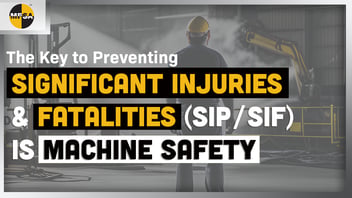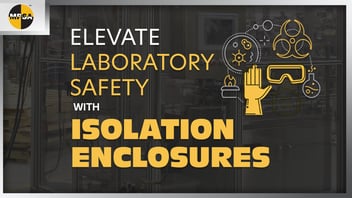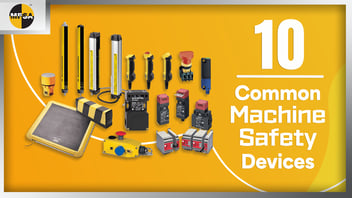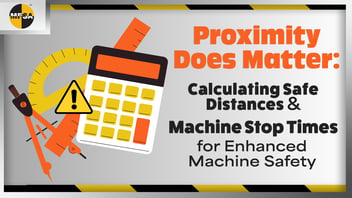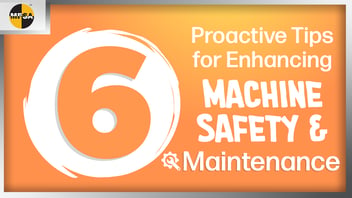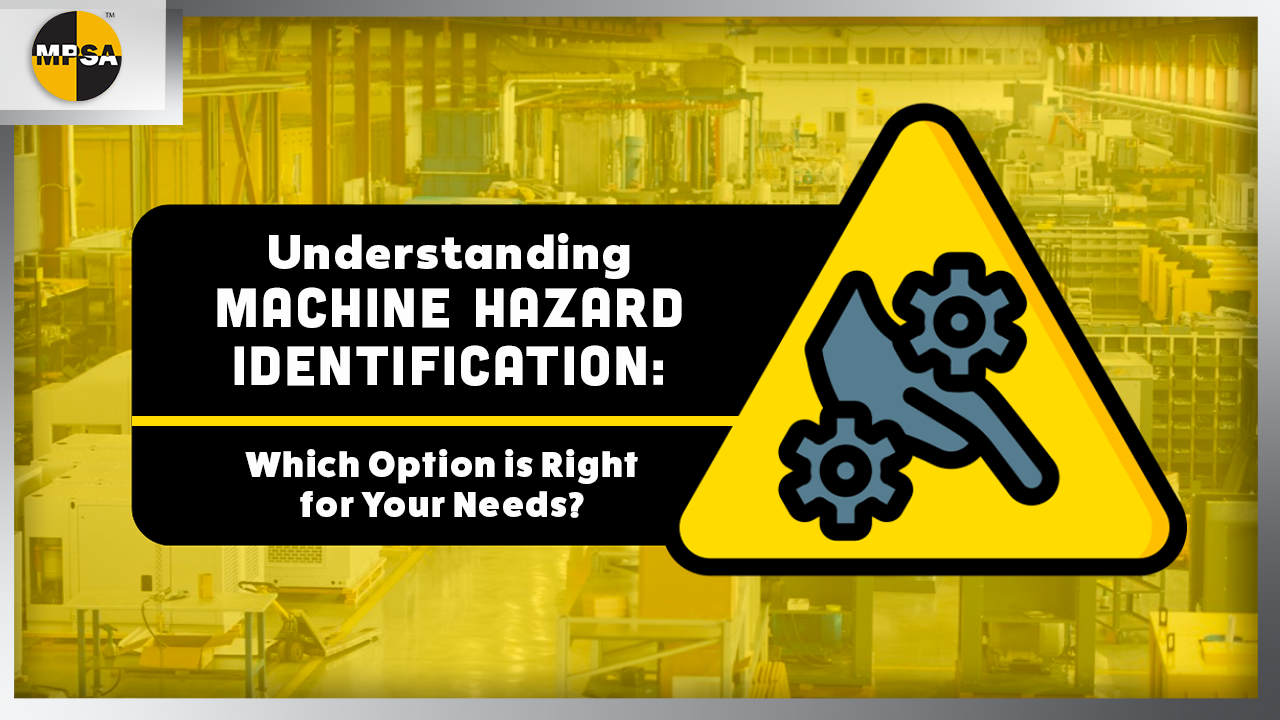
Understanding Machine Hazard Identification: Which Option is Right for Your Needs?

Posted By: David Kerr
June 4th, 2024
Ensuring machine safety is a regulatory requirement and crucial to maintaining a safe and efficient working environment. The complexities of identifying and mitigating machine hazards can be overwhelming, especially for decision-makers who don't work directly with the machinery. However, these leaders must make crucial machine safety decisions without in-depth technical knowledge. To navigate these challenges, Machine & Process Safety Assessment (MPSA) offers three tailored options to meet your specific needs wherever you are in your machine safety journey.
Skip to a Section
Why is Machine Hazard Identification Important? | MPSA's Machine Hazard Identification Options | Option One: Safety Survey | Option Two: Risk Assessment | Option Three: Risk Assessment & Detailed Scope | Choosing the Right Option for Your Needs | Frequently Asked Questions
Download Hazard Identification Flyer | Contact Us
Key Takeaways
✔️ Machine safety is vital for creating a safe and productive work environment, meeting regulatory requirements, managing risks, enhancing productivity, protecting equipment and assets, and promoting employee morale and engagement. ✔️ MPSA offers three key options for machine hazard identification: a Machine Safety Survey for quick and efficient identification of machine safety risks, a Machine Safety Risk Assessment for more detailed insight into potential hazards, and a Machine Safety Risk Assessment and detailed scope that provides a comprehensive solution inclusive of risk assessment and detailing the scope and cost of required upgrades. ✔️ These three options depend on specific safety needs, the degree of disruption acceptable to your operations, and the budget allocated for safety assessments. |
Why is Machine Hazard Identification Important?
Ensuring Workplace Safety: Identifying machine hazards helps prevent accidents, injuries, and fatalities in the workplace. By recognizing potential machinery-related dangers, professionals can proactively mitigate risks and create a safer working environment for all employees.
Compliance with Regulations: Industrial manufacturing facilities are subject to various safety regulations and standards set forth by governmental bodies. Proper hazard identification ensures that organizations comply with these regulations, avoiding fines, penalties, and legal issues.
Risk Management: Understanding machine hazards allows professionals to assess and manage risks effectively. By identifying potential hazards, assessing their likelihood and severity, and implementing appropriate controls, businesses can reduce the risk of incidents and protect employees and assets.
Enhancing Productivity: A safe working environment leads to improved productivity. Businesses can minimize downtime due to accidents or equipment failures by addressing machine hazards, maintaining workflow continuity, and optimizing operational efficiency.
Protecting Equipment and Assets: Hazard identification is about safeguarding personnel and protecting valuable machinery and assets. By being aware of potential hazards that could damage equipment, professionals can implement maintenance practices and safety measures to prolong the lifespan of machinery and reduce repair costs.
Employee Morale and Engagement: A workplace that prioritizes safety through effective hazard identification fosters a positive work culture. Employees feel valued and supported when their well-being is a top priority, leading to increased morale, higher engagement levels, and lower turnover rates.
MPSA's Machine Hazard Identification Options
At MPSA Safety, we understand that every facility is unique, with its own set of challenges and constraints. That's why we offer three distinct options for hazard identification, each designed to meet different needs in terms of cost and complexity. Let's review:
Option 1: Machine Safety Survey
The machine safety survey is an ideal starting point for those who need a quick and efficient way to identify machine safety risks. This option is designed to help you rapidly pinpoint hazardous machines and understand the scope of necessary upgrades. The Machine Safety Survey is a great option for a preliminary assessment and offers a cost-effective and efficient means of surveying multiple machines during a single site visit.
Key Features:
- Time-Efficient Analysis: Requires approximately one hour per machine, making it perfect for facilities with multiple installations.
- Minimal Disruption: Limited coordination efforts and minimal interference with machine operations ensure that your productivity remains intact.
- Comprehensive Standards Compliance: Evaluates machines following OSHA requirements and ANSI/ISO/NFPA standards.
- Prioritization and Budgeting: Provides a clear picture of gaps, required upgrades, and budgetary estimates for corrective actions.
- Certified Expertise: Conducted by certified Machine Safety Experts (CMSE), Licensed Machine Safety Specialists (LMSS), or certified TÜV Functional Safety Engineers.
Deliverables:
- Survey Results: Presented in an Excel file detailing the findings and identified risks.
- Corrective Actions: Description, recommendations, and budgetary cost estimates (+/- 25%) are provided in an Excel file.
 Safety Survey Example
Safety Survey Example
Option Two: Risk Assessment
When a more thorough examination is required, the Machine Safety Risk Assessment provides a detailed and systematic evaluation of machine hazards. This option is particularly useful for companies with mandatory risk assessment requirements or those seeking to determine performance level (PL) requirements for each identified risk. The Machine Safety Risk Assessment is essential for new machine designs and installations, providing a detailed analysis that ensures compliance and safety.
Key Features:
- In-Depth Evaluation: Requires approximately one day per machine, covering all routine tasks such as operation, setup, adjustments, retooling, and maintenance.
- Rigorous Compliance: Conforms to ISO-12100, ANSI B11.0, and RIA TR 15 risk assessment standards, meeting OSHA and requirements.
- Inclusive Engagement: This involves all impacted parties, including machine operators, mechanics, cleaners, facility automation/instrumentation, and EHS teams.
- Expert Assessment: Conducted by certified Machine Safety Experts (CMSE), Licensed Machine Safety Specialists (LMSS), or certified TÜV Functional Safety Engineers.
Deliverables:
- Risk Assessment Report: Findings are presented in an Excel file with visual and graphical aids.
- Corrective Actions: An Excel file provides recommendations and budgetary cost estimates (+/—25%).
 Examples of Risk Prioritization Matrix
Examples of Risk Prioritization Matrix
Option Three: Risk Assessment & Detailed Scope
For a comprehensive solution beyond risk assessment, the Machine Safety Risk Assessment & Detailed Scope option includes a full evaluation along with a detailed scope and price for required safety upgrades. This option is perfect for those needing an all-encompassing solution. The Machine Safety Risk Assessment & Detailed Scope is the most comprehensive option, providing an in-depth analysis and practical solutions for ensuring machine safety and compliance.
Key Features:
- Thorough Examination: Requires one day for risk assessment and an additional day for controls and mechanical reverse engineering to evaluate existing safety circuitry.
- Detailed Scope Development: This includes all elements of the Machine Safety Risk Assessment, plus a detailed description and price of all guarding and safety control solutions.
- Turnkey Solutions: Describes turnkey solutions to eliminate or reduce all noted machine safety risks to acceptable levels.
- Client Flexibility: Allows clients to determine if required upgrades can be done internally or need to be outsourced.
- Certified Expertise: Conducted by certified Machine Safety Experts (CMSE), Licensed Machine Safety Specialists (LMSS), or certified TÜV Functional Safety Engineers.
Deliverables:
- Risk Assessment Report: Findings presented in an Excel file.
- Visual Aids: Corrective actions shown using edited photos and layout drawings in a Word document.
- Conceptual Layouts: Plan-view conceptual mechanical layout drawings in PDF format.
- Safety Control Scope: A detailed safety-control scope is presented in a Word document.
- Fixed Price Proposal: Describe turnkey solutions, including final engineering, schematics, drawings, fabrication, installation, and an ISO 13849 validation report, presented in a Word document.
Choosing the Right Option for Your Needs
Choosing the right option depends on your specific requirements, such as the scope of your safety needs, the level of disruption your operations can tolerate, and your budget for safety assessments. Here are a few questions to consider:
- What is the scope of your current safety needs?
- The Machine Safety Survey is ideal if you need a high-level overview with prioritization of assets for remediation (high, medium, low risk).
- The Machine Safety Risk Assessment is recommended for a thorough risk examination of task-based hazards or to achieve CE compliance.
- For a comprehensive solution with detailed scope and pricing, choose the Machine Safety Risk Assessment & Detailed Scope.
- What level of disruption can your operations tolerate?
- The Machine Safety Survey offers minimal disruption with limited coordination efforts.
- The Machine Safety Risk Assessment and Detailed Scope options require more time but provide a deeper analysis.
- What is your budget for safety assessments?
- The Machine Safety Survey is the most cost-effective option.
- The Machine Safety Risk Assessment offers a balance between cost and depth.
- The Machine Safety Risk Assessment & Detailed Scope provides the most detailed and actionable insights but is more expensive.
Ready to ensure the safety of your working environment? Contact our team at MPSA to discuss the best machine hazard identification option for your business. At MPSA Safety, we are committed to guiding you through this process and providing the expertise and support needed to achieve full compliance and operational excellence.
Subscribe to our blog
Most Recent
Ensuring machine safety is a regulatory requirement and crucial to maintaining a safe and efficient working environment. The complexities of...
No matter the severity of the injury, whether it's a near miss, serious injury, or fatality, taking proactive measures can help prevent future SIF (...
It's that time of year when ghosts and goblins come out to play, and while we enjoy a good scare during the Halloween season, there's one thing that...
Safety must stand as an unwavering pillar in any laboratory setting, ensuring innovation thrives without compromising the well-being of those at the...
At your facilities, the utmost priority is the safety of your employees and the integrity of your operations. Every day, your machines are crucial in...
Ensuring the safety and well-being of employees operating industrial machinery requires a deliberate and well-designed approach. Applying “quick fixes
Did you know there's a crucial connection between machine safety maintenance and the well-being of your workers? It's true! And as technology...
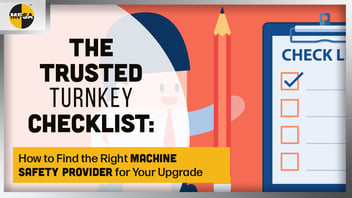
The Trusted Turnkey Checklist: How to Find the Right Machine Safety Provider for Your Upgrade Project
Here at MPSA, we define turnkey machine safety solutions as designed, built, installed, validated, and ready to operate. But finding a trusted...





